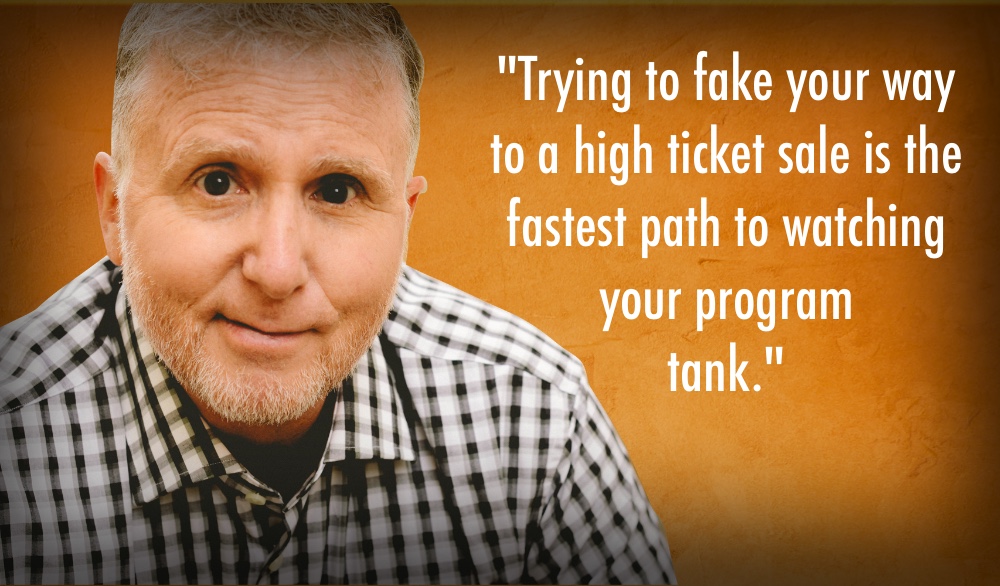
It’s the holy grail for entrepreneurs – creating a hot high ticket program that actually sells.
You make lots of money.
Your clients get huge results.
Your position in the market goes through the roof so you can continue to attract premium clients willing to pay you premium rates.
There’s just one catch:
You will never sell high ticket programs by giving them a fancy name.
Or a fancy website.
You will never sell them by adding a bunch of stuff to them. No matter how cool they sound or how many luxury experiences you add to them.
You sell high ticket programs by solving high ticket problems.
So .. what is a high ticket problem?
They are the problems costing your ideal clients in huge ways:
- Costing them time.
- Costing them money.
- Costing them lost opportunity.
- Costing them experiences they can’t replicate, or can never have again.
- Costing them cherished relationships.
The good news is: Once you take this into account, amazing things happen to your conversion rate. And here are three keys to help ensure that result:

Build your program around the problem
Trying to fake your way to a high ticket sale is the fastest path to watching your program tank.
You must build your program around the high ticket problem to solve the problem:
It must be a ‘right now’ problem.
It must be at the top of their list of things to get right.
It must be the thing that pops into their mind as soon as they wake up in the morning.
Or what wakes them up at night.
The problem must be costly.
And your program must tick off every single box that moves them to believe it’s the solution they’ve been searching for.
Instilling that belief is the key that anchors the willingness to fully invest in your value.

Make your program market specific
Let’s say the problem you solve is anxiety. There’s a massive difference what you can charge based on what that anxiety is costing a particular market.
Anxiety that keeps a beginning entrepreneur from taking action isn’t costing them a lot.
First, they aren’t making money to start with.
Second, they likely have a day job, which is putting a roof over their head and food on the table.
On the other hand, anxiety that keeps a CEO from taking effective action may be costing them millions.
It may even been putting their mega-salary job in danger.
When the threat is big, so is the motivation to invest in a solution.
So … guess who is willing to pay more to dissolve their anxiety?
The exact same problem or condition impacts different markets in different ways.
The market that has the most to lose by letting the problem you solve fester, is willing to pay a lot more for you to help them solve it.

Make your program situation specific
People spending a lot of money on a solution want to be certain you know exactly what they’re going through before they spend it.
They want to feel you understand the problem they’re facing and the situation they’re in. To the degree that, when you talk about it, it almost feels psychic.
Because in their mind:
If you know the problem within an inch of its life, you’re going to know how to solve it.
Not in a blind, blanket cookie-cutter, one-size-fits-all way, that’s bound to miss the mark.
But in a way that fits their needs and their situation.
But how do you come up with those specific situations when every prospect is coming from a different place?
If you know your ideal client, you will know hot button situations a majority of them are suffering from and can relate to.
For example, if I’m helping someone with online ads I could mention:
- They’re getting ever more expensive – and squeezing your profit margins to the core.
- The major platforms keep changing the rules, so your foolproof system that worked yesterday may be useless today.
- Facebook can shut down your account for unexplained “Terms of Service violations. Which fills you with mortal terror every time you log in.
These are common situations that telegraph a clear message: I know what you’re going through. So I can solve it.
The best marketing is a response to what the prospect is already feeling, and already looking for.
And the best positioning for your high ticket program responds to the situation your prospect is already in.
To sum it up:
Your ideal clients’ willingness to invest in a high ticket program isn’t influenced by how much stuff you shovel at them or how long you work with them.
(In fact, people who have resources will actually pay you more if the solution takes LESS time).
It involves how expensive the problem is.
And how much they give up or lose if it continues to go unsolved.
When you build a program around a specific problem, geared to resolving specific situations for specific markets that can afford to invest … they are much more likely to.
